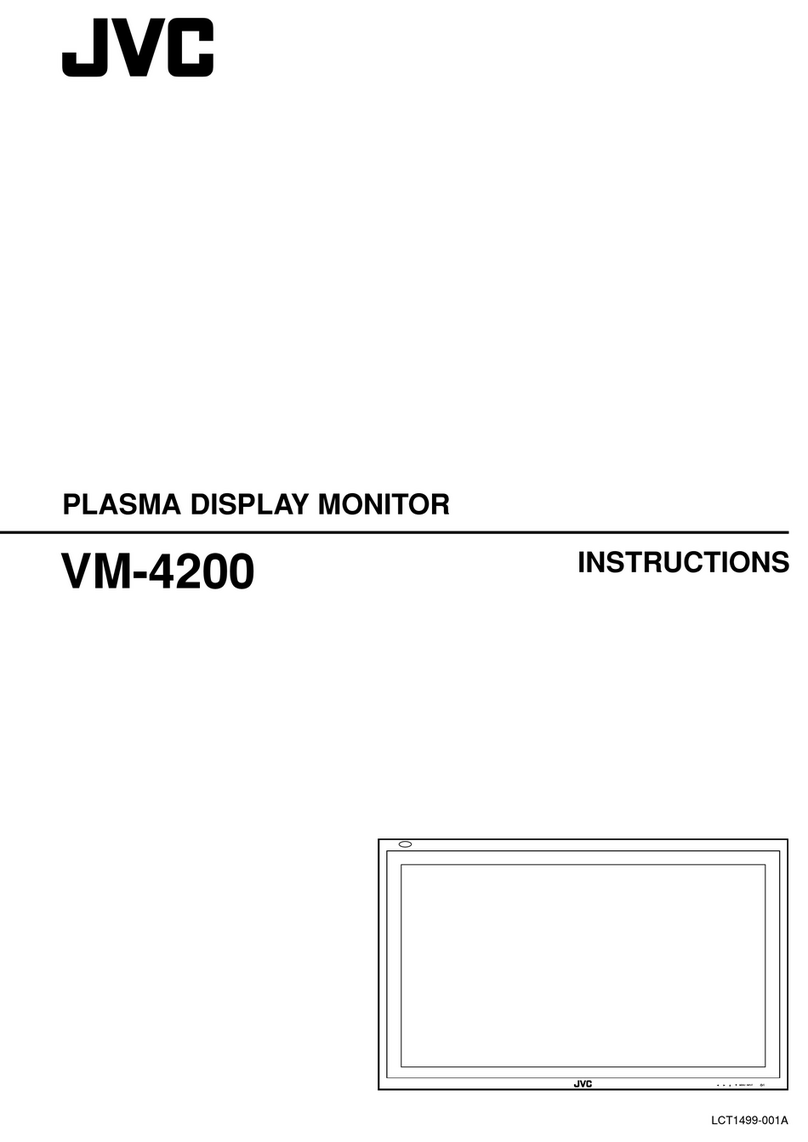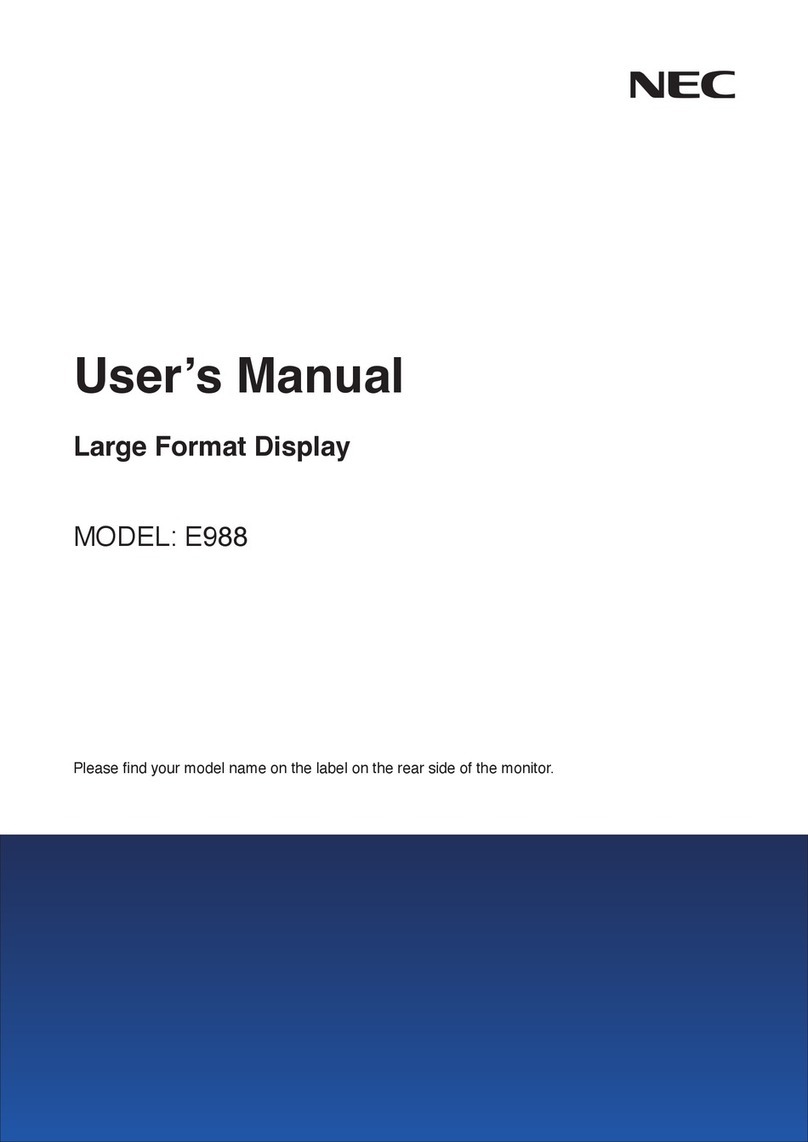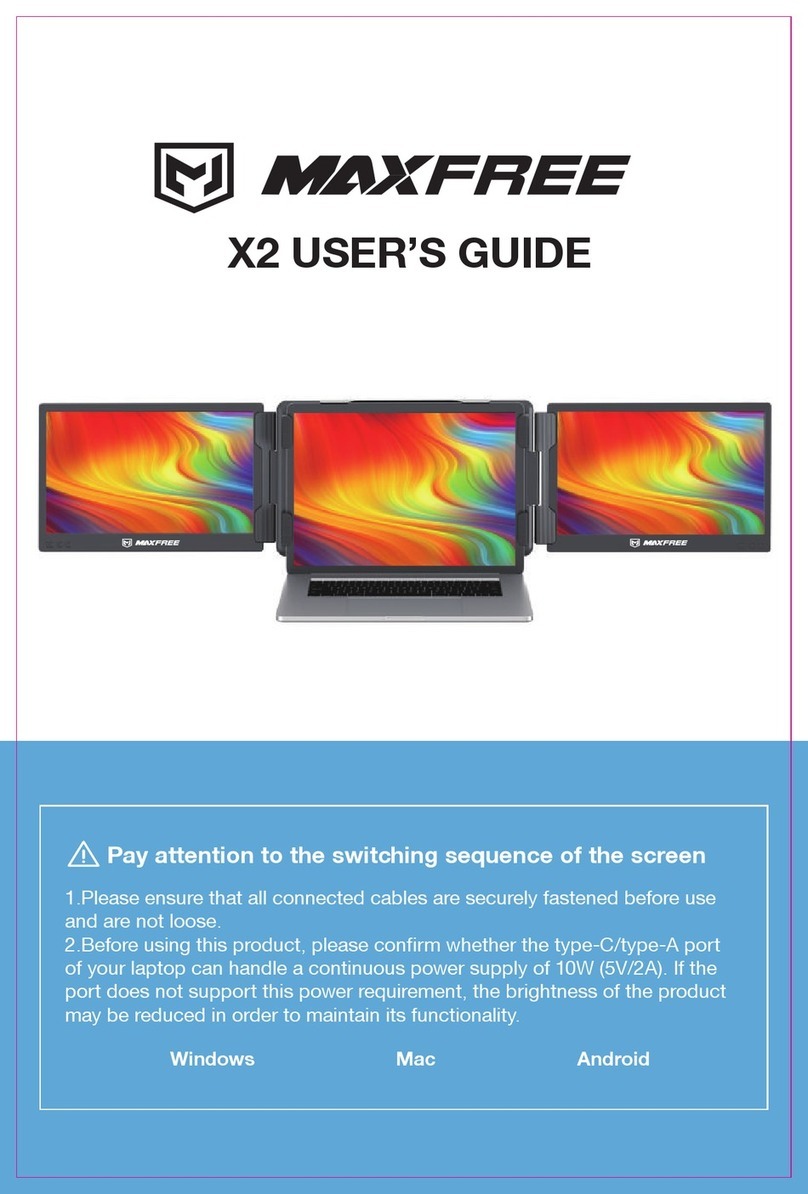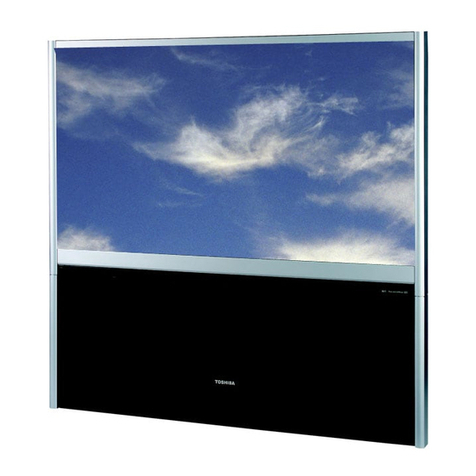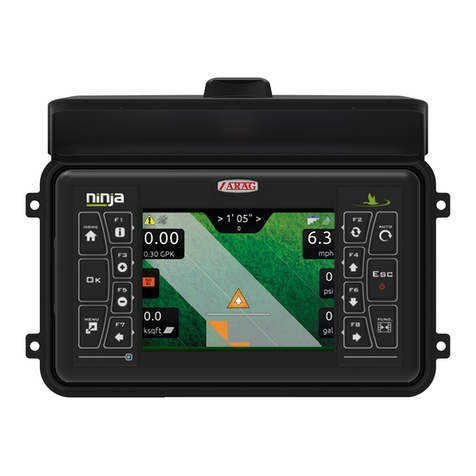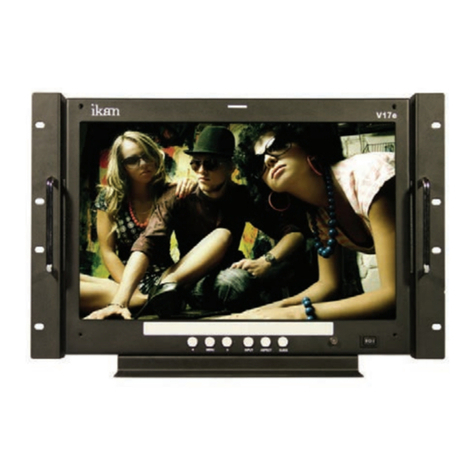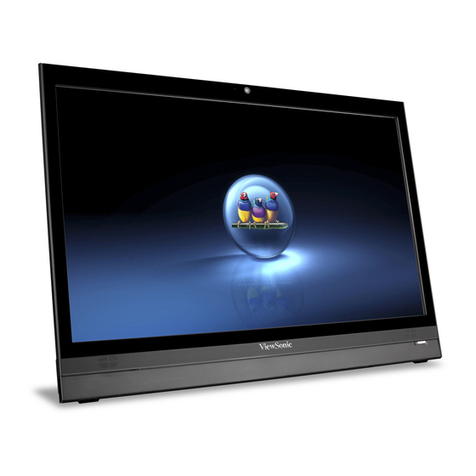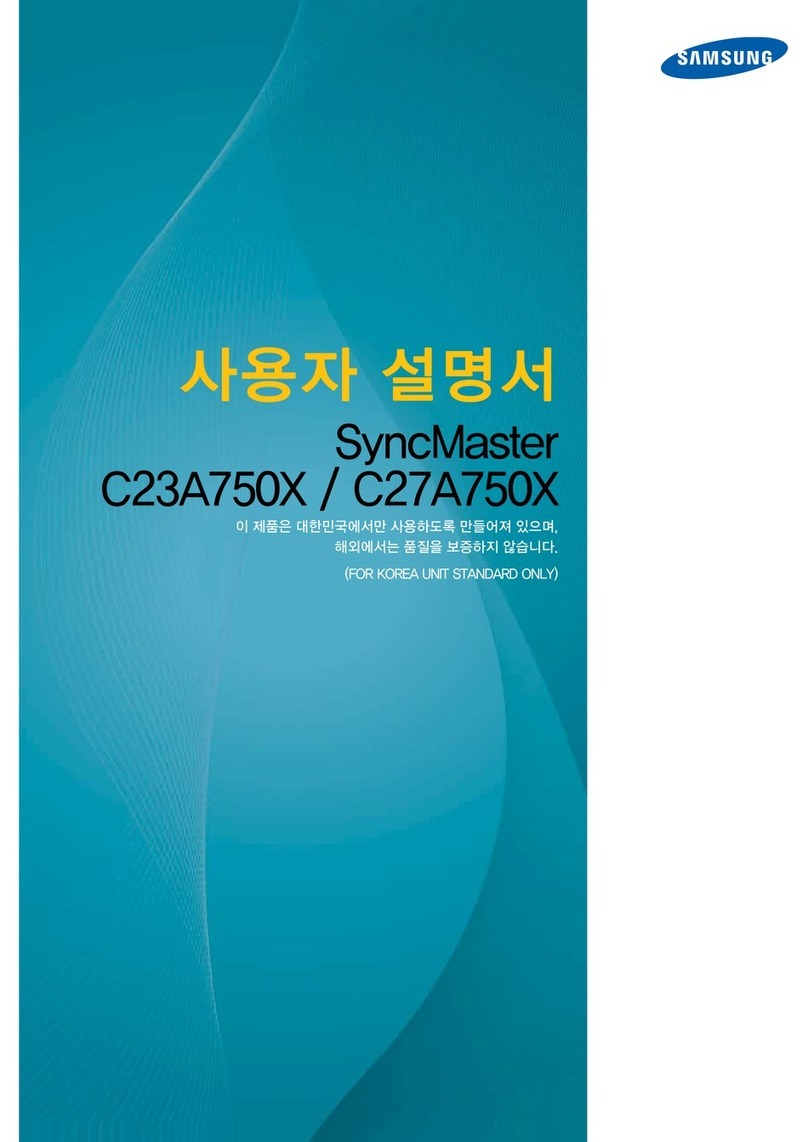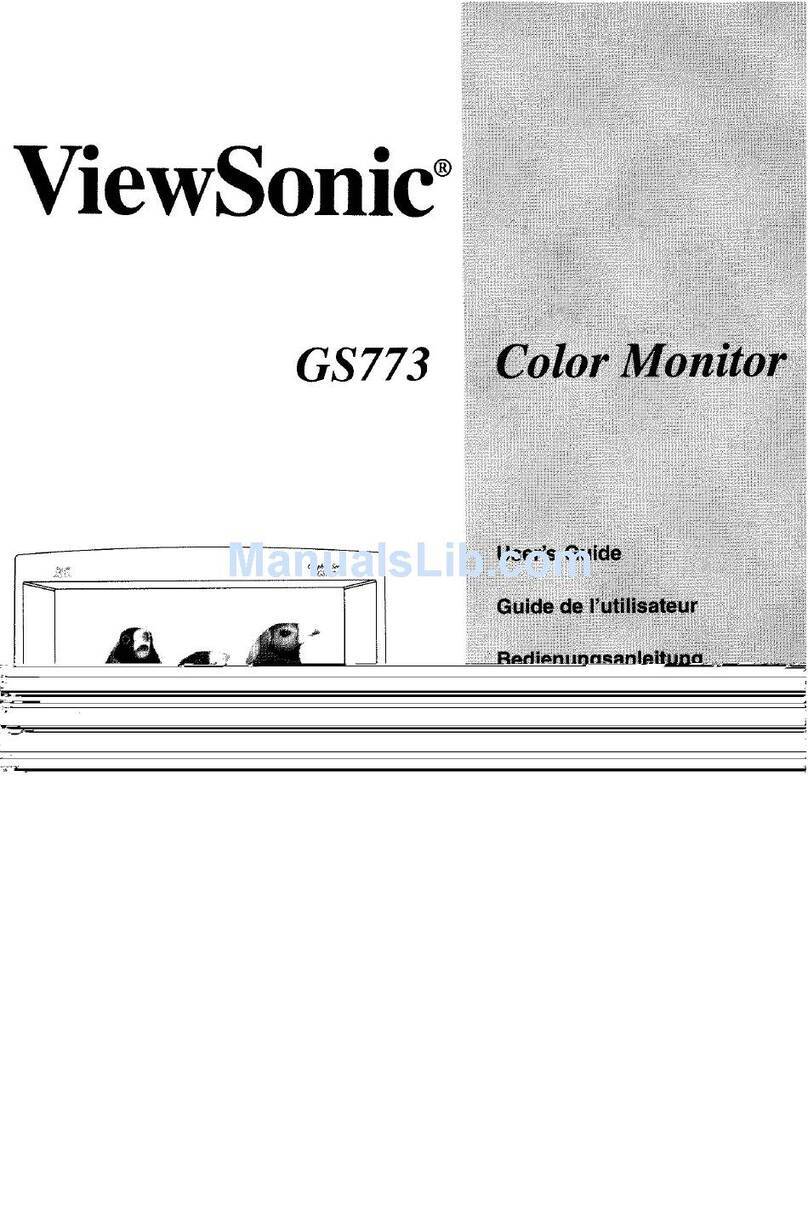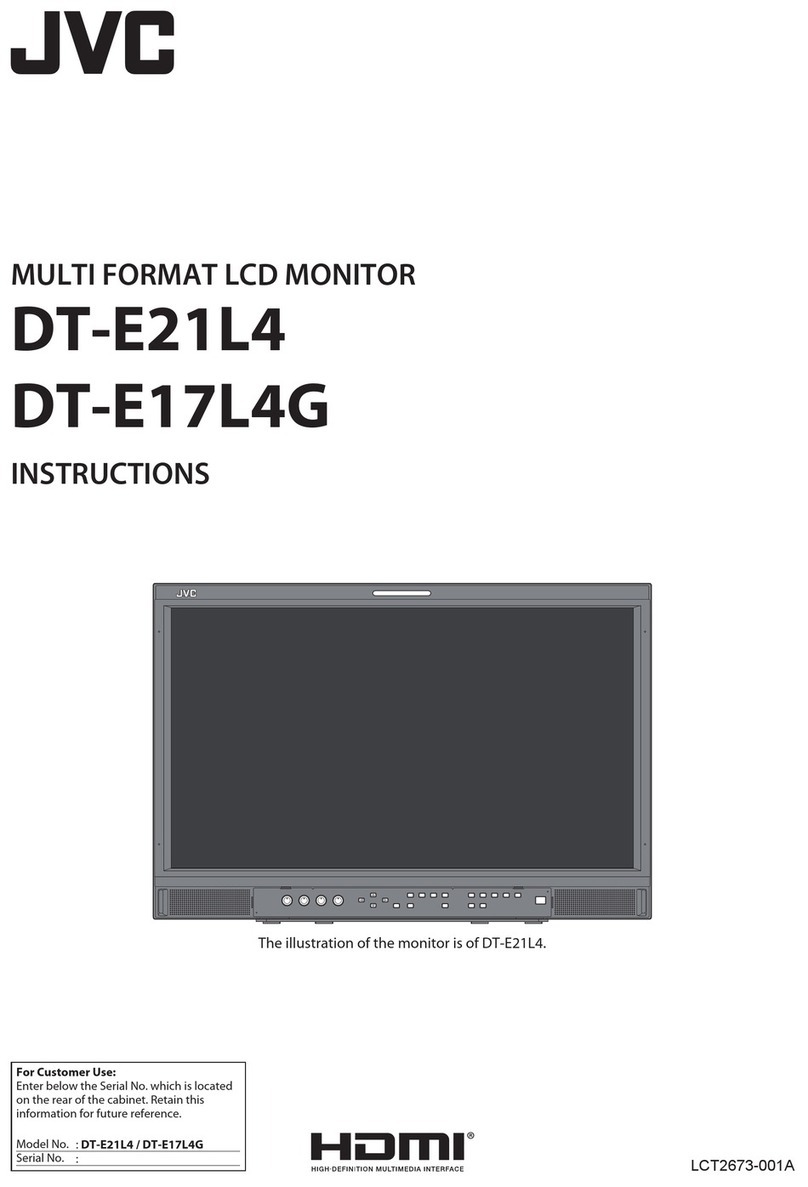GFS DGF7 User manual

CONTENTS PAGE 2OF 15
DGF7 Display reference manual, rev. 1, feb 22, 2022 Ground Fault Systems B.V.
1. GENERAL DESCRIPTION 3
2. FUNCTIONALITY 4
2.1 Pushbuttons 4
2.1.1 G/F current display 4
2.1.2 G/F Trip Level display 4
2.1.3 Trip code display 4
2.1.4 Trip code display during power down situations 5
2.1.5 Reset function 5
2.1.6 Relay test 5
2.1.7 LCD test 6
2.1.8 Alarm code display 6
2.2 Datalink error code 6
3. PARAMETER SETTING 7
3.1 Display Settings 7
3.2 Display setup procedure 7
4. CONNECTIONS AND PRECAUTIONS 8
5. TECHNICAL SPECIFICATIONS 9
5.1 Serial datalink circuit 9
5.2 Terminals 9
5.3 Environment 9
5.4 Mechanical properties 9
6. APPLICABLE STANDARDS 10
7. TABLES AND FIGURES 11
7.1 Table 1 - DGF7-3 dipswitch settings 11
7.2 Table 2 - DGF7 Display settings versus current read-out 12
7.3 Table 3 - Trip codes 13
7.4 Figure 1 - Typical Field Connection using DGF7-3 with built-in core balance, remote reset
and DGF7 Display. 14
7.5 Figure 2 - Dimensions DGF7 Display 15

PAGE 3OF 15
DGF7 Display reference manual, rev. 1, feb 22, 2022 Ground Fault Systems B.V.
1. GENERAL DESCRIPTION
The DGF7 Display is a door mounted self powered operator interface to be used in conjunction with the
DGF7-3 Ground Fault (G/F) protection system. It has a four digit LCD panel that normally shows the
magnitude of residual current flowing to ground as it is measured by the DGF7-3. If a trip occurred and
the ground fault current has been removed, the display will show, in flashing mode, the measured
current just prior to the trip. The two integrated pushbuttons also allow for other data to be accessed,
such as trip codes, the G/F Trip Level as it is set by means of dipswitches on the DGF7-3, and various
parameters inside the display itself that modify its behaviour.
The DGF7 Display has settable parameters to enable the user to tailor the DGF7 Display to their needs,
Relay Test on/ off, G/F Current Display Mode (‘%’, ‘A’and ‘kA’) and CS Configuration.
The G/F Current Display Mode is a ‘real world’, auto-ranging, readout in relative or absolute mode for
different current sensors.
When the DGF7-3 G/F protection system loses control voltage, the DGF7 Display memorises the actual
trip state, which remains accessible to the operator by pressing the ‘SHOW TRIP’button. This feature is
especially useful when pulse tripping a breaker that also supplies control voltage to the DGF7-3 G/F
protection system.
The pushbuttons can also be used to test the segments of the LCD and to invoke a relay test on the
DGF7-3.
The display is connected to the DGF7-3 base unit using a single twisted pair of wires. No separate power
supply is needed.

PAGE 4OF 15
DGF7 Display reference manual, rev. 1, feb 22, 2022 Ground Fault Systems B.V.
2. FUNCTIONALITY
2.1 Pushbuttons
The DGF7 Display has two pushbuttons, marked ‘SHOW TRIP’ and ‘RESET’.
With these two buttons a variety of reading and setting options can be performed.
2.1.1 G/F current display
When left untouched (except while in parameter set-up mode, see section 3), the DGF7 Display will
always return to showing the current flowing to ground, commonly referred to as ‘G/F current’. The user
has two options for showing this current:
Relative format: as a percentage of the G/F Trip Level. The G/F Trip Level is set by means of
dipswitches 1, 2 and 3 on the DGF7-3 base unit. It is the intention that the user checks the ‘%’ box
on the DGF7 Display’s front panel with a marker.
Absolute format, i.e. in engineering units: A or kA. In this mode the DGF7 Display uses the P4
parameter (see section 3), specifying the CS configuration, to calculate absolute from relative
current. It is the intention that the user checks the ‘A’ or ‘kA’ box on the DGF7 Display’s front panel
with a marker, as is appropriate for the selected configuration. Absolute format is the factory default
setting.
Normally the system shows the G/F current’s actual value, refreshing it every 0,5 seconds. When the
DGF7-3 base unit is in a tripped state, with the fault current removed, the value flashes and refers to the
situation just prior to trip. If the fault current is still active, the actual value will be displayed.
When the G/F current exceeds the system’s measuring range, the display shows
Out
, meaning ‘Out of
range’. Depending on various internal variables, the maximum value that can be represented (whether in
relative or absolute format) before resorting to the ‘Out of range’ indication varies from around 400 to
800 % of the G/F Trip Level.
Back to Table 2.
2.1.2 G/F Trip Level display
The DGF7 Display is able to show the G/F Trip Level Setting (by holding the ‘SHOW TRIP’ button longer
than 2 seconds). All supported configurations are shown in table 1. For the configurations the user needs
to set internal parameter P4 as is detailed in section 3.
2.1.3 Trip code display
Pushing the ‘SHOW TRIP’button when the G/F current is shown, calls forward the trip code display. If no
trip condition is present, the display shows as
tr:--
. Further operator action lacking, the display will
return to G/F current after 2 seconds. If, on the other hand, a trip condition is present, the format
becomes
tr:xx
in which
xx
is the trip code, indicating the cause of the trip. The
xx
codes are explained
on the front panel of the DGF7 Display. A complete list with more extensive explanations is available in
section 7.3. Further operator action lacking, the display will return to G/F current after 10 seconds.
Pushing the ‘SHOW TRIP’button again while the
tr:xx
trip code is on the display makes the display return
to G/F current instantaneously.
Pressing the ‘RESET’button while the
tr:xx
trip code is on the display, is interpreted as a request to
reset the trip. Both the trip relay and the trip registration will be reset IF possible. During reset action the
display will show a moving dot, then show the
tr:--
format of the trip code and return to G/F current

PAGE 5OF 15
DGF7 Display reference manual, rev. 1, feb 22, 2022 Ground Fault Systems B.V.
2 seconds later. Note however, that if at the time of reset a different trip was already lurking, the old trip
registration will clear giving way to the new one, and the trip relay will remain activated without glitches.
Resetting a trip will be refused if the cause of the trip has not cleared yet. In that case the display will
show a 1,5 seconds message ‘---‘, then return to the trip code. Of course one should first clear the fault
in the field that caused the current increase in the first place before resetting, or else the DGF7-3 will
reset its relay and trip out immediately again.
Resetting of the trip relay is meaningless if dipswitches 7 and 8 on the DGF7-3 base unit are set for
Pulsed Relay Operating Mode. However, the registration of the trip behaves as described above in
conjunction with the ‘RESET’pushbutton.
2.1.4 Trip code display during power down situations
When the DGF7-3 base unit loses control voltage, it sends out trip status information on its datalink
before shutting down. The DGF7 Display receives this information, stores it in memory and then shuts
down itself, which shows by the LCD panel blanking.
Thanks to a built-in backup power source the trip information can be retrieved for at least ten hours after
loss of control voltage. Pressing the ‘SHOW TRIP’button will bring forward the trip code display as it was
described above, revealing whether or not the system was tripped at the loss of control voltage, and if
so, what was the cause of the trip-out. The information remains visible until the pushbutton is released or
backup power is exhausted.
This feature is useful when pulse tripping a breaker that also supplies control voltage to the G/F
protection system. Especially when several systems control one single breaker (with their relay contacts
in parallel), which prevents the user from having to figure out which of them caused a given trip without
having live systems anymore.
For as long as control voltage remains absent, no other functionality than the one described here is
available.
The memorised trip information will reset automatically when control voltage is restored. If the DGF7-3 is
still in a tripped state, the Display will first show
tr:xx
, than
---
and finally
0,000
or the actual G/F
current value. The previous trip value is lost.
2.1.5 Reset function
The DGF7 Display can be used to reset the DGF7-3 after a trip occurred. A reset will only be granted if
the cause of the trip is not present anymore.
To reset the DGF7-3:
Press the ‘SHOW TRIP’ button to read the trip cause.
Press the ‘RESET’ button to reset the indicated trip, the LCD shows a moving dot, followed by
tr:--
,
then goes back to normal current read-out.
If the cause of the trip is cleared but another one is lurking, then pressing the ‘RESET’ button will reset
the trip indication on the LCD and the new trip code is shown. The relay of the DGF7-3 however will
remain in the trip state, without glitches.
2.1.6 Relay test
Keeping the ‘SHOW TRIP’button pressed and then pressing the ‘RESET’button invokes a test, which
switches an AC voltage onto the CS sensor input of the DGF7-3 base unit’s built-in processor. The voltage
is scaled to simulate a residual current of 1,5 –3 times the G/F Trip Level setpoint. The base unit will trip
on G/F after the delay defined on its dipswitches (plus 0,4 s).
The trip code
tr:00
is called forward by pressing the ‘SHOW TRIP’button. The ‘RESET’button can then
be pushed to reset the trip. You cannot reset without first pressing the ‘SHOW TRIP’ button.

PAGE 6OF 15
DGF7 Display reference manual, rev. 1, feb 22, 2022 Ground Fault Systems B.V.
By means of parameter P2 the relay test feature can be switched off, so as not to allow for personnel to
cause inadvertent trips from a door mounted operator interface.
Tests can still be started from the DGF7-3 base unit.
If one tries to start a test while the feature is switched off, the display will show a 1,5 seconds message
‘OFF’. If one tries to start a test while the system is already tripped, the display will show a 1,5 seconds
message ‘---’. See chapter 3 for the parameter settings.
2.1.7 LCD test
The LCD panel can be tested at all times by keeping the ‘RESET’ button pressed longer than 2 seconds.
All segments of the LCD panel will turn on, displaying
8.8:8.8
until the pushbutton is released.
2.1.8 Alarm code display
The current version of the DGF7-3 has no alarm functions.
The display will show
AL:--
if the ‘SHOW ALARM’/ ‘RESET’ button is pressed.
2.2 Datalink error code
At the moment only one error code is used:
E:04.
The DGF7 Display does not receive data via the datalink. This code may be seen for a few seconds when
the base unit is powered down.

PAGE 7OF 15
DGF7 Display reference manual, rev. 1, feb 22, 2022 Ground Fault Systems B.V.
3. PARAMETER SETTING
3.1 Display Settings
Five settable parameters stored in non-volatile memory enable the user to tailor the DGF7 Display to their
needs. However, to discourage unauthorised manipulation, parameters can only be changed by going
through the procedure outlined in section 3.2.
Param.
Description
Values
P1
Alarm Reset Style
♦
0Standard style; pressing ‘RESET’ resets the alarm
relay and registration only if the alarm is manually
resettable and the cause has cleared
1Not used in this configuration
P2
Start Relay Test
Control
♦
0Start test capability (from the DGF7 Display) is
switched on
1Start test capability is switched off;
P3
G/F Current
Display Mode
♦
0Relative mode: G/F Current is displayed as a
percentage of the G/F Trip Level that is set on the
DGF7-3 dipswitches; please check the ‘%’ box on
the front panel 1
1Absolute mode: G/F Current is displayed in A or kA,
as is applicable. If a 5000:5 interposing CT is used,
check the ‘kA’ box on the front panel 1
P4
CS Configuration
See table 2
♦
0 Internal/External 500:1 CS or Interposing 5000:5 CT
1 External 1000:1 CS
2 External 2000:1 CS
3 External 10.000:1 CS
4 Interposing 500:5 CT
P5
Alarm
annunciation
status of this
display
♦
0 This display is not regarded as an alarm
annunciating output.
1 Not used in this configuration
♦Factory settings
1
Use a waterproof marker.
3.2 Display setup procedure
Five settable parameters stored in non-volatile memory enable the user to tailor the DGF7 Display to their
needs. However, to discourage unauthorised manipulation, parameters can only be changed by going
through a procedure.
Contact us at info(@)groundfaultsystems.com for the procedure or look in the paper manual included
with the unit.
Back to Functionality. Back to G/F Trip Level Display. Back to Relay Test.

PAGE 8OF 15
DGF7 Display reference manual, rev. 1, feb 22, 2022 Ground Fault Systems B.V.
4. CONNECTIONS AND PRECAUTIONS
Please consult the following checklist when applying the DGF7 Display.
1. Place the DGF7 Display on the door or front panel of the clean dry enclosure that accommodates the
DGF7-3 G/F Protection Unit it is connected to. The panel cut-out is a rectangle measuring 85 mm
vertically, and 70 mm horizontally. Use the U-shaped mounting bracket coming with the unit to
clamp it onto the panel.
2. The two connections to the DGF7 Display are by means of screw clamp pull-apart terminals.
Terminals will accept 0,5-2,5 mm2, 20-14 AWG solid or stranded conductors. The user may want to
identify the following terminals as indicated on the display’s product label:
S1 for connecting the datalink from the DGF7-3 (Signal plus 5V)
C for connecting the datalink from the DGF7-3 (Common)
3. For good EMC behaviour it is important (as in any installation) to run all wiring, especially if
unshielded, close along the chassis or in metal ducts, avoiding excess lengths.
4. If the distance between the Display and the DGF7-3 exceeds 1 m, shielded cable is recommended.
The shield must be connected to chassis ground by means of a clamp, at the DGF7-3 side, where
the FB terminal is bonded to chassis ground. From the clamp to the DGF7-3 terminals the wires can
be left unshielded.

PAGE 9OF 15
DGF7 Display reference manual, rev. 1, feb 22, 2022 Ground Fault Systems B.V.
5. TECHNICAL SPECIFICATIONS
5.1 Serial datalink circuit
Datalink voltage
Max. 5 V DC
Maximum total length
Max. 5 m, within one enclosure. Use shielded cable for
over 1 m.
5.2 Terminals
Type
Pull-apart
UL/CSA rating
300 V AC, 10 A
VDE rating
250 V AC, 12 A,
pollution degree 3,
over-voltage category III
Insulation stripping length
7 mm
Torque
0,4 –0,6 Nm
Field wiring
0,5 –2,5 mm2(VDE)
20 - 14 AWG (UL/CSA), Cu, solid or stranded
5.3 Environment
Operating temperature
-20 C to +60 C
Storage temperature
-25 C to +80 C
Humidity
85% max (no condensation)
Ingress protection
IP55
5.4 Mechanical properties
Height
95 mm
Width
81 mm
Depth
38 mm (excluding bracket and screws)
Panel cut-out
85 x 70 mm (H x W)
Mounting bracket
2 pieces M5 x 16 plus rings and bracket supplied
Weight (open)
0,16 kg
Weight (packaged)
0,19 kg

PAGE 10 OF 15
DGF7 Display reference manual, rev. 1, feb 22, 2022 Ground Fault Systems B.V.
6. APPLICABLE STANDARDS
EN 61000-6-3
Electromagnetic compatibility (EMC) –Part 6-3: Generic standards –Emission
standard for residential, commercial and light-industrial environments (=lowest
levels)
30-230 MHz 30 dBV at 10 m distance
230-1000 MHz 37 dBV at 10 m distance
EN 61000-6-2
Electromagnetic compatibility (EMC) –Part 6-2: Generic standards –Immunity
standard for industrial environments (=highest levels)
80-1000 MHz with 80% AM modulation up to 10 V/m at 3 m distance from source
EN 61000-4-2
Electromagnetic compatibility (EMC) for industrial-process measurement and
control equipment –Part 4-2: Electrostatic discharge (ESD) immunity
EN 61000-4-3
Electromagnetic compatibility (EMC) for industrial-process measurement and
control equipment –Part 4-3: Radiated electromagnetic field immunity
EN 61000-4-4
Electromagnetic compatibility (EMC) for industrial-process measurement and
control equipment –Part 4-4: Electrical fast transient/burst immunity
EN 61000-4-5
Electromagnetic compatibility (EMC) for industrial-process measurement and
control equipment –Part 4-5: Surge immunity
EN 61000-4-6
Electromagnetic compatibility (EMC) for industrial-process measurement and
control equipment –Part 4-6: Conducted radio frequency field immunity
EN 61000-4-11
Electromagnetic compatibility (EMC) for industrial-process measurement and
control equipment –Part 4-11: Voltage dips/drops/variations immunity
EN 60947-5-1
Low-voltage switchgear and controlgear –Part 5-1: Control circuit devices and
switching elements –Electromechanical control circuit devices
IEC 60755
General requirements for residual current operated protective devices
UL
UL 1053 Ground-Fault Sensing and Relaying Equipment, Class 1
CSA
C22.2 No. 144-M91 Ground Fault Circuit Interrupters
CE
CE mark –Declaration of Conformity

PAGE 11 OF 15
DGF7 Display reference manual, rev. 1, feb 22, 2022 Ground Fault Systems B.V.
7. TABLES AND FIGURES
7.1 Table 1 - DGF7-3 dipswitch settings
‘R’ denotes right and ‘L’ denotes left.
Values are primary currents for a 500:1 ratio internal or external Current Sensor.
For other ratio’s see Table 2.
Switch no.
Parameter
Set to
Meaning
123
Ground Fault
Trip level
L L L ♦
L L R
L R L
L R R
R L L
R L R
R R L
R R R
0,030 A
0,100 A
0,250 A
0,37 A
0,50 A
1,00 A
3,00 A
0,060 A
456
Ground Fault
Trip Delay time
and Trip Inhibit
L L L ♦
L L R
L R L
L R R
R L L
R L R
R R L
R R R
20 ms without Trip Inhibit
20 ms with Trip Inhibit
100 ms without Trip Inhibit
100 ms with Trip Inhibit
300 ms without Trip Inhibit
300 ms with Trip Inhibit
1 s without Trip Inhibit
3 s without Trip Inhibit
78
Operating Mode
L L ♦
L R
R L
R R
Continuous Non-Failsafe operation
Continuous Failsafe operation
Pulsed Non-Failsafe operation
Pulsed Failsafe operation
♦Factory settings
Back to G/F Trip Level display.

PAGE 12 OF 15
DGF7 Display reference manual, rev. 1, feb 22, 2022 Ground Fault Systems B.V.
7.2 Table 2 - DGF7 Display settings versus current read-out
Values are primary currents.
No.
0 (a)
0 (b)
1
2
3
4
DGF7-3
setting
Internal/
external
500:1
Interposing
5000:5
External
1000:1
External
2000:1
External
10.000:1
Interposing
500:5
0,030 A
0,030 A
0,030 kA
0,060 A
0,120 A
0,60 A
3,00 A
0,100 A
0,100 A
0,100 kA
0,200 A
0,40 A
2,00 A
10,0 A
0,250 A
0,250 A
0,250 kA
0,50 A
1,00 A
5,0 A
25,0 A
0,37 A
0,37 A
0,37 kA
0,74 A
1,48 A
7,4 A
37 A
0,50 A
0,50 A
0,50 kA
1,00 A
2,00 A
10,0 A
50 A
1,00 A
1,00 A
1,00 kA
2,00 A
4,0 A
20,0 A
100 A
3,00 A
3,00 A
3,00 kA
6,0 A
12,0 A
60 A
300 A
0,060 A
0,060 A
0,060 kA
12,0 A
24,0 A
120 A
600 A
Note: When using a 5000:5 interposing CT, the user needs to remember that displayed currents
are in kA; (see section 2.3), the ‘kA’ box can be checked with a marker on the display’s front panel,
making this obvious.
The G/F Trip Level can be called forward by keeping the ‘SHOW TRIP’ pushbutton pressed longer
than 2 seconds. The information remains visible until the pushbutton is released.
Back to G/F Trip Level display. Back to Display Settings. Back to Table 1.

PAGE 13 OF 15
DGF7 Display reference manual, rev. 1, feb 22, 2022 Ground Fault Systems B.V.
7.3 Table 3 - Trip codes
Code
Description
00
TEST GROUND FAULT
The user started a test and as a result of that the system tripped.
01
GROUND FAULT
Residual current exceeded the G/F Trip Level during the G/F Trip Delay, but never
exceeded the H/C Trip Level.
02
SHORT CIRCUIT TO GROUND
Residual current exceeded the S/C Trip Level; system response was instantaneous.
In case Type 2 Co-ordination is used, the upstream device tripped correctly, and
after the current went to zero as a result, the DGF7-3 activated its trip relay to
isolate the faulty circuitry.
03
BACKUP TRIP (UPSTREAM FAILED)
This trip can only occur when the Trip Inhibit function is used. Residual current
exceeded the H/C Trip Level, but the upstream device failed to trip. The DGF7-3
then tripped as a last resort. The contactor should be inspected, since its contacts
may well be damaged.
04
EXTERNAL CS OPEN CIRCUIT
The connection to an external CS was detected to be open for approximately 2
seconds. This error is latched, so intermittent failures are captured.
05
EXTERNAL CS SHORTED
The connection to an external CS was detected to be shorted for approximately 2
seconds. This error is latched, so intermittent failures are captured.
06
TRIP FAILED
A trip state on top of one of the possible trips described above. Residual current
remained high after a trip. Pressing reset clears this trip, but not yet the trip state,
such that the LCD display now shows the original trip code and the red LED on the
DGF7-3 will now show the original trip’s flashing code.
08
FAILSAFE LOSS OF CONTROL VOLTAGE
The DGF7-3 base unit is used in one of the failsafe trip relay modes, and it lost
control voltage while not being tripped.
Back to Trip code display.

PAGE 14 OF 15
DGF7 Display reference manual, rev. 1, feb 22, 2022 Ground Fault Systems B.V.
7.4 Figure 1 - Typical Field Connection using DGF7-3 with built-in core balance, remote
reset and DGF7 Display.

PAGE 15 OF 15
DGF7 Display reference manual, rev. 1, feb 22, 2022 Ground Fault Systems B.V.
7.5 Figure 2- Dimensions DGF7 Display
This manual suits for next models
1
Table of contents


